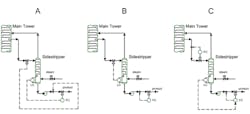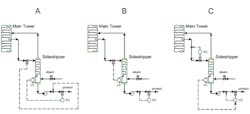Automation: Carefully Consider Sidestripper Control
Last month, we examined how pressure balance can control maximum flow in sidedraw systems (“Ponder Parallel Paths”). This month, let’s look at the objectives of sidedraw systems and how the main control approaches compare.
[pullquote]
Sidedraw systems have two major objectives:
1. Draw a product at a specified condition. This may be a rate or a product purity or specification of some type. The draw rate may be set independently or reset by the operating system to meet a purity or performance specification.
2. Protect the equipment involved.
Figure 1 shows three sidedraw systems, A, B and C. In each, the draw rate is directly set on flow control. The major equipment protection step is maintaining a liquid level to safeguard the product pump. (A system without a pump still would need the upstream liquid level to provide a seal to prevent vapor entering the downstream product.)
Do all three systems meet the two major objectives?
System A maintains a level protecting the pump by manipulating the final product rate — by directly varying the bottoms product rate.
System B maintains a level protecting the pump by manipulating the feed rate to the sidestripper — by varying the liquid draw from the main tower to the sidestripper.
System C maintains a level protecting the pump by manipulating the final product rate as in System B — but by using a cascade from level to flow. (This does not change the overall logic of the system.) The target product rate is approximated by controlling the feed rate into the sidestripper. This system assumes a roughly constant ratio of bottoms product to feed rate.
Figure 1. System A provides better product pump protection in the event of tray flooding.
All three systems seem to meet the objectives of meeting a fixed product rate and protecting the bottoms pump. However, System C has two defects. First, the product rate is only an approximation; Systems A and B directly control the bottoms product rate to a specified value. Second, in System C, the feed line to the sidestripper uses an orifice plate as a flow measurement device. The orifice plate imposes a pressure drop in the system. As discussed last month, this pressure drop reduces the system draw capacity. If elevations suffice, this may not be important. Nevertheless, treat System C as a marginal option.
Systems A and B present an interesting choice. A review of my previous columns and articles would show that I highly favor System B, as do other authors. However, from a technical perspective, System A has a slight advantage. This raises two questions: “Why is System B shown so often?” and “Why is System A superior?”
Let’s keep in mind that Systems A and B both work and are used extensively. A plant should standardize on one option or the other — i.e., every sidedraw should use the same control configuration. Keeping everything alike vastly simplifies operator understanding and helps avoids errors.
Now back to the open questions.
The reason authors so favor System B is simple. It draws up into a simpler sketch. No lines cross each other and the drawing is compact. Because the approach works and is widely used, it appears in article illustrations unless some specific point in the discussion requires a different system.
System A is technically superior — but not under normal control conditions where both systems meet the overall objectives. However, under abnormal conditions, control behavior can vary. Perhaps the most important difference is the response to a steam control valve failing open. In many units, if the valve fails open the steam rate will flood the sidestripper. One of the consequences of flooding is that liquid stays on the trays and doesn’t reach the tower bottoms.
In System B, the resultant drop in bottoms level opens the feed valve to the sidestripper. So, despite the trays remaining flooded and little (if any) extra liquid likely reaching the tower bottoms, the bottoms rate remains constant. The bottoms liquid level will continue to drop. Starving the pump of liquid is very possible.
In contrast, when the level of the sidestripper in System A drops, the flow out immediately decreases. This helps keep liquid on the pump suction. Eventually, the flow rate will drop to zero, but System A gives operations staff more time to respond to the pump than if level is completely lost.
Control systems must meet required process objectives. In selecting the approach to use for an operating unit, always consider steady state, dynamic and abnormal operating characteristics of the system.


